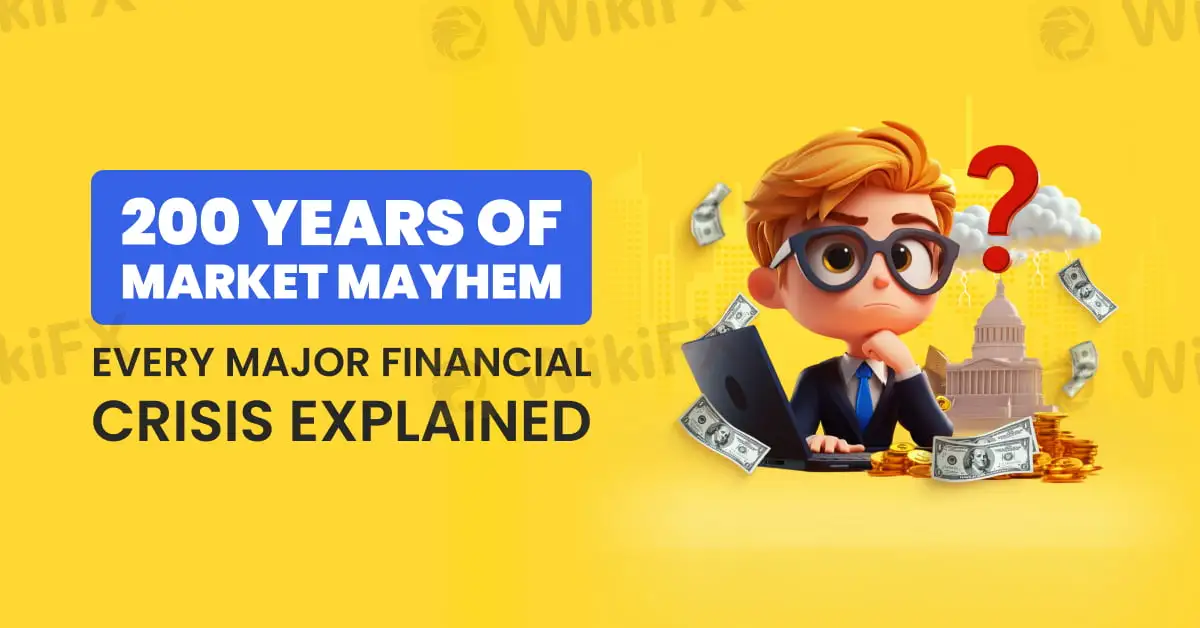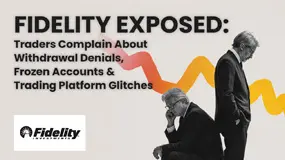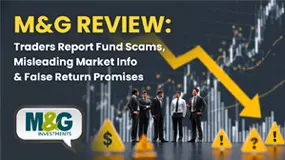简体中文
繁體中文
English
Pусский
日本語
ภาษาไทย
Tiếng Việt
Bahasa Indonesia
Español
हिन्दी
Filippiiniläinen
Français
Deutsch
Português
Türkçe
한국어
العربية
200 Years of Market Mayhem: Every Major Financial Crisis Explained
Abstract:Financial crises have shaped economies for centuries, often leaving a trail of devastation in their wake. While each crisis has its own unique causes, recurring themes, such as speculation, regulatory failures, and external shocks, continue to threaten global markets. This article explores the most significant financial collapses in history, revealing the patterns that link past crises to modern financial instability.

Financial crises have shaped economies for centuries, often leaving a trail of devastation in their wake. While each crisis has its own unique causes, recurring themes, such as speculation, regulatory failures, and external shocks, continue to threaten global markets. This article explores the most significant financial collapses in history, revealing the patterns that link past crises to modern financial instability.

The first recorded financial crisis in the United States occurred in 1792, triggered by speculative trading in government bonds. A wave of panic led to bank failures, forcing the newly established U.S. financial system to stabilise through the intervention of Alexander Hamilton. Decades later, the 1837 U.S. Banking Crisis saw widespread bank failures after a speculative land boom collapsed, deepening a long economic downturn.
By 1857, a combination of rail industry overexpansion and declining European demand for U.S. goods led to another financial crash, proving that global markets were becoming increasingly interconnected. This was followed by the 1873 Long Depression, a pan-European financial crisis sparked by bank failures in Austria and the collapse of the U.S. railroad industry.

As financial markets grew, crises became more complex. The 1893 U.S. Banking Crisis saw the collapse of over 500 banks due to a failing gold standard and declining investor confidence. Decades later, the infamous 1929 Great Depression began with the Wall Street Crash, leading to mass unemployment and a prolonged economic downturn that lasted a decade.
By the 1970s, external shocks played a larger role in financial instability. The 1973 Oil Crisis was triggered by an OPEC embargo, leading to soaring fuel prices and inflation. The 1979 Second Oil Crisis compounded these problems, causing a global economic slowdown.

As global markets became more intertwined, financial crises took on a new dimension. The 1982 Latin American Debt Crisis arose when major South American economies, burdened by unsustainable debt, defaulted on their loans. The shockwaves were felt worldwide, reinforcing the risks of excessive borrowing.
The 1987 Black Monday crash saw stock markets collapse globally, with the Dow Jones losing 22% of its value in a single day—an early warning of the risks associated with computerised trading. The 1992 European Exchange Rate Mechanism Crisis followed, as speculative attacks on the British pound forced the UK to withdraw from the ERM.
By 1994, Mexicos economy was in turmoil due to unsustainable debt and investor panic, leading to the Tequila Crisis, which necessitated an emergency bailout. Three years later, the 1997 Asian Financial Crisis saw massive currency devaluations across Thailand, Indonesia, and South Korea, exposing weaknesses in emerging market economies.

The 2000 Dot-Com Bubble Burst wiped out billions in speculative internet-based stocks, underscoring the dangers of overhyped technology investments. Just eight years later, the 2008 Global Financial Crisis, driven by subprime mortgage lending and excessive risk-taking, plunged the world into a deep recession. The fallout led to sweeping banking regulations and government bailouts.
In 2010, the European Sovereign Debt Crisis emerged as countries like Greece, Portugal, and Spain struggled with debt repayment, testing the resilience of the Eurozone. Most recently, the 2020 Covid-19 Global Financial Crisis caused markets to crash as the pandemic shut down economies worldwide, prompting unprecedented fiscal stimulus and monetary interventions.

Financial crises are inevitable, but history shows that regulatory oversight, responsible investment strategies, and early intervention can mitigate their impact. As markets evolve, understanding past collapses remains crucial in preventing the next economic disaster.

Disclaimer:
The views in this article only represent the author's personal views, and do not constitute investment advice on this platform. This platform does not guarantee the accuracy, completeness and timeliness of the information in the article, and will not be liable for any loss caused by the use of or reliance on the information in the article.
Read more

Fidelity Exposed: Traders Complain About Withdrawal Denials, Frozen Accounts & Platform Glitches
Does Fidelity Investments prevent you from accessing funds despite numerous assurances on your requests? Do you witness an account freeze by the US-based forex broker every time you request withdrawal access? Do you struggle with an unstable trading platform here? Is the slow Fidelity customer service making you face forced liquidation? These issues haunt traders, with many of them voicing their frustration on several broker review platforms such as WikiFX. In this Fidelity review article, we have shared quite a few complaints for you to look at. Read on!

Exposing The Trading Pit: Traders Blame the Broker for Unfair Withdrawal Denials & Account Blocks
Did you receive contradictory emails from The Trading Pit, with one approving payout and another rejecting it, citing trading rule violations? Did you purchase multiple trading accounts but receive a payout on only one of them? Did The Trading Pit prop firm refund you for the remaining accounts without clear reasoning? Did you face account bans despite using limited margins and keeping investment risks to a minimum? These are some raging complaints found under The Trading Pit review. We will share some of these complaints in this article. Take a look.

M&G Review: Traders Report Fund Scams, Misleading Market Info & False Return Promises
Applying for multiple withdrawals at M&G Investments but not getting it into your bank account? Do you see the uncredited withdrawal funds out of your forex trading account on the M&G login? Does the customer support service fail to address this trading issue? Does the misleading market information provided on this forex broker’s trading platform make you lose all your invested capital? Were you lured into investing under the promise of guaranteed forex returns? These issues have become highly common for traders at M&G Investments. In this M&G review article, we have echoed investor sentiments through their complaint screenshots. Take a look!

INZO Broker MT5 Review 2025: A Trader's Guide to Features, Fees and Risks
INZO is a foreign exchange (Forex) and Contracts for Difference (CFD) brokerage company that started working in 2021. The company is registered in Saint Vincent and the Grenadines and regulated offshore. It focuses on serving clients around the world by giving them access to popular trading platforms, especially MetaTrader 5 (MT5) and cTrader. The company offers different types of trading instruments, from currency pairs to cryptocurrencies. It aims to help both new and experienced traders. Read on to know more about it.
WikiFX Broker
Latest News
2 Malaysians Arrested in $1 Million Gold Scam Impersonating Singapore Officials
Moomoo Singapore Opens Investor Boutiques to Strengthen Community
OmegaPro Review: Traders Flood Comment Sections with Withdrawal Denials & Scam Complaints
An Unbiased Review of INZO Broker for Indian Traders: What You Must Know
BotBro’s “30% Return” Scheme Raises New Red Flags Amid Ongoing Fraud Allegations
The 5%ers Review: Is it a Scam or Legit? Find Out from These Trader Comments
WikiEXPO Dubai 2025 Concludes Successfully — Shaping a Transparent, Innovative Future
Admirals Cancels UAE License as Part of Global Restructuring
Forex Expert Recruitment Event – Sharing Insights, Building Rewards
Exness Broker Expands in South Africa with Cape Town Hub
Currency Calculator



